2013 Hyundai Sonata Hybrid engine overheat
[x] Cancel search: engine overheatPage 272 of 425
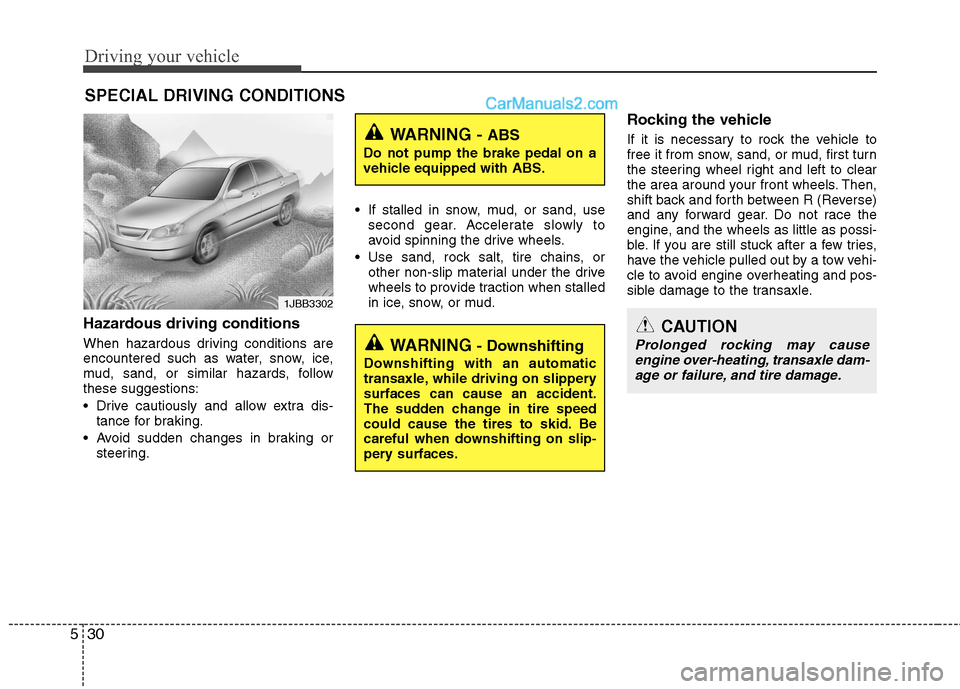
Driving your vehicle
30 5
Hazardous driving conditions
When hazardous driving conditions are
encountered such as water, snow, ice,
mud, sand, or similar hazards, follow
these suggestions:
Drive cautiously and allow extra dis-
tance for braking.
Avoid sudden changes in braking or
steering. If stalled in snow, mud, or sand, use
second gear. Accelerate slowly to
avoid spinning the drive wheels.
Use sand, rock salt, tire chains, or
other non-slip material under the drive
wheels to provide traction when stalled
in ice, snow, or mud.
Rocking the vehicle
If it is necessary to rock the vehicle to
free it from snow, sand, or mud, first turn
the steering wheel right and left to clear
the area around your front wheels. Then,
shift back and forth between R (Reverse)
and any forward gear. Do not race the
engine, and the wheels as little as possi-
ble. If you are still stuck after a few tries,
have the vehicle pulled out by a tow vehi-
cle to avoid engine overheating and pos-
sible damage to the transaxle.
SPECIAL DRIVING CONDITIONS
1JBB3302
WARNING - ABS
Do not pump the brake pedal on a
vehicle equipped with ABS.
WARNING - Downshifting
Downshifting with an automatic
transaxle, while driving on slippery
surfaces can cause an accident.
The sudden change in tire speed
could cause the tires to skid. Be
careful when downshifting on slip-
pery surfaces.
CAUTION
Prolonged rocking may cause
engine over-heating, transaxle dam-
age or failure, and tire damage.
Page 275 of 425
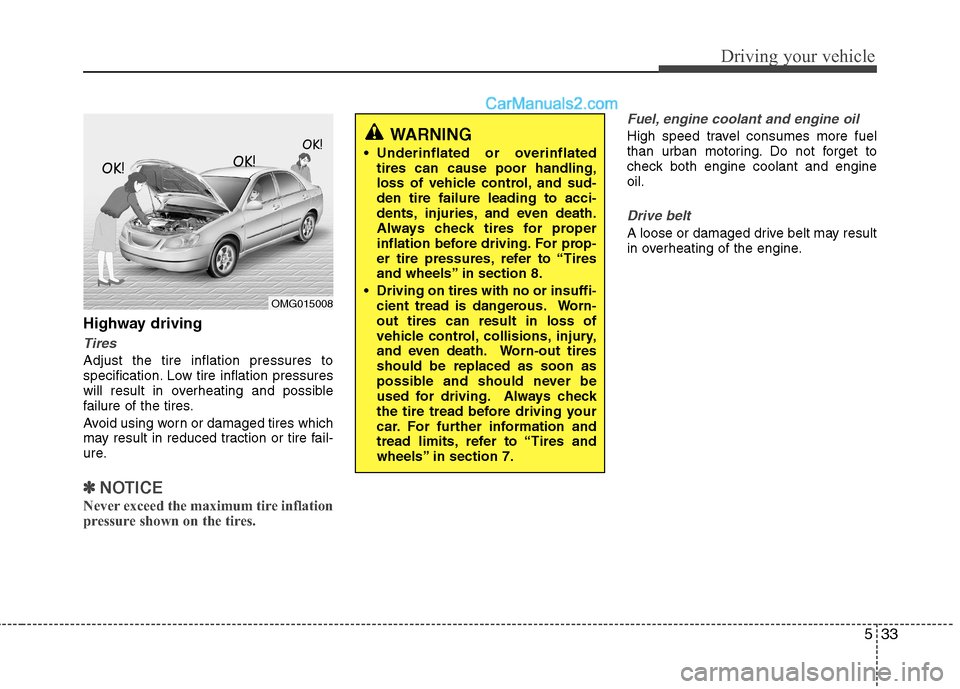
533
Driving your vehicle
Highway driving
Tires
Adjust the tire inflation pressures to
specification. Low tire inflation pressures
will result in overheating and possible
failure of the tires.
Avoid using worn or damaged tires which
may result in reduced traction or tire fail-
ure.
✽ ✽
NOTICE
Never exceed the maximum tire inflation
pressure shown on the tires.
Fuel, engine coolant and engine oil
High speed travel consumes more fuel
than urban motoring. Do not forget to
check both engine coolant and engine
oil.
Drive belt
A loose or damaged drive belt may result
in overheating of the engine.
WARNING
Underinflated or overinflated
tires can cause poor handling,
loss of vehicle control, and sud-
den tire failure leading to acci-
dents, injuries, and even death.
Always check tires for proper
inflation before driving. For prop-
er tire pressures, refer to “Tires
and wheels” in section 8.
Driving on tires with no or insuffi-
cient tread is dangerous. Worn-
out tires can result in loss of
vehicle control, collisions, injury,
and even death. Worn-out tires
should be replaced as soon as
possible and should never be
used for driving. Always check
the tire tread before driving your
car. For further information and
tread limits, refer to “Tires and
wheels” in section 7.
OMG015008
Page 287 of 425
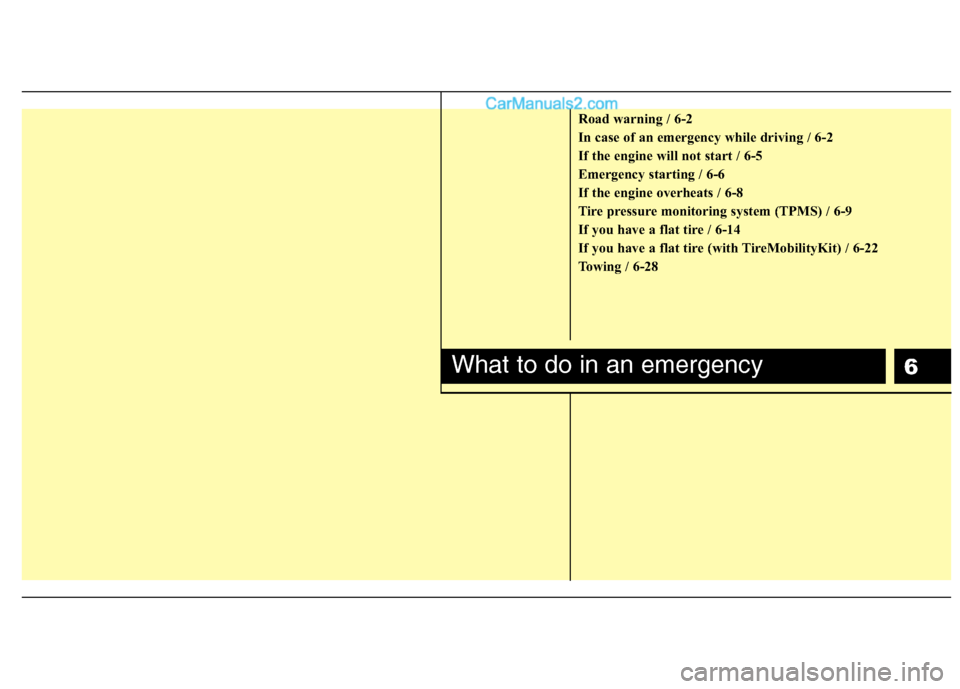
6
Road warning / 6-2
In case of an emergency while driving / 6-2
If the engine will not start / 6-5
Emergency starting / 6-6
If the engine overheats / 6-8
Tire pressure monitoring system (TPMS) / 6-9
If you have a flat tire / 6-14
If you have a flat tire (with TireMobilityKit) / 6-22
Towing / 6-28
What to do in an emergency
Page 293 of 425

67
What to do in an emergency
Jump starting procedure
1. Open the cover of battery in trunk room.
2. Make sure the booster battery is 12-
volt and that its negative terminal is
grounded.
3. If the booster battery is in another vehi-
cle, do not allow the vehicles to touch.
4. Turn off all unnecessary electrical loads.
5. Connect the jumper cables in the exact
sequence shown in the illustration.
First connect one end of a jumper
cable to the positive terminal of the
discharged battery (1), then connect
the other end to the positive terminal
on the booster battery (2). Proceed to
connect one end of the other jumper
cable to the negative terminal of the
booster battery (3), then the other end
to a solid, stationary, metallic point (for
example, the trunk latch) away from
the battery (4). Do not connect it to or
near any part that moves when the
engine is cranked.
Do not allow the jumper cables to con-
tact anything except the correct battery
terminals or the correct ground. Do not
lean over the battery when making
connections.6. Start the engine of the vehicle with the
booster battery and let it run at 2,000
rpm, then start the engine of the vehi-
cle with the discharged battery.
If the cause of your battery discharging is
not apparent, you should have your vehi-
cle checked by an authorized HYUNDAI
dealer.
Push-starting
Vehicles equipped with automatic
transaxles cannot be push-started.
Follow the directions in this section for
jump-starting.CAUTION- Battery cables
Do not connect the jumper cable
from the negative terminal of the
booster battery to the negative ter-
minal of the discharged battery.
This can cause the discharged bat-
tery to overheat and crack, releas-
ing battery acid.
WARNING
Never tow a vehicle to start it
because the sudden surge forward
when the engine starts could cause
a collision with the tow vehicle,
resulting in serious injury or death.
Page 294 of 425
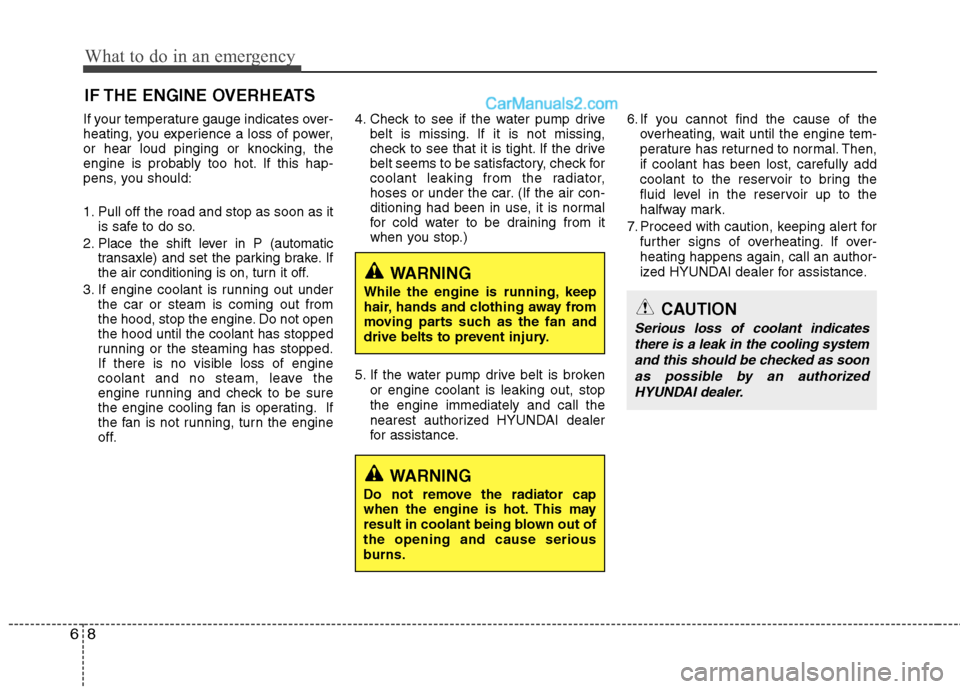
What to do in an emergency
8 6
IF THE ENGINE OVERHEATS
If your temperature gauge indicates over-
heating, you experience a loss of power,
or hear loud pinging or knocking, the
engine is probably too hot. If this hap-
pens, you should:
1. Pull off the road and stop as soon as it
is safe to do so.
2. Place the shift lever in P (automatic
transaxle) and set the parking brake. If
the air conditioning is on, turn it off.
3. If engine coolant is running out under
the car or steam is coming out from
the hood, stop the engine. Do not open
the hood until the coolant has stopped
running or the steaming has stopped.
If there is no visible loss of engine
coolant and no steam, leave the
engine running and check to be sure
the engine cooling fan is operating. If
the fan is not running, turn the engine
off.4. Check to see if the water pump drive
belt is missing. If it is not missing,
check to see that it is tight. If the drive
belt seems to be satisfactory, check for
coolant leaking from the radiator,
hoses or under the car. (If the air con-
ditioning had been in use, it is normal
for cold water to be draining from it
when you stop.)
5. If the water pump drive belt is broken
or engine coolant is leaking out, stop
the engine immediately and call the
nearest authorized HYUNDAI dealer
for assistance.6. If you cannot find the cause of the
overheating, wait until the engine tem-
perature has returned to normal. Then,
if coolant has been lost, carefully add
coolant to the reservoir to bring the
fluid level in the reservoir up to the
halfway mark.
7. Proceed with caution, keeping alert for
further signs of overheating. If over-
heating happens again, call an author-
ized HYUNDAI dealer for assistance.
WARNING
While the engine is running, keep
hair, hands and clothing away from
moving parts such as the fan and
drive belts to prevent injury.
CAUTION
Serious loss of coolant indicates
there is a leak in the cooling system
and this should be checked as soon
as possible by an authorized
HYUNDAI dealer.
WARNING
Do not remove the radiator cap
when the engine is hot. This may
result in coolant being blown out of
the opening and cause serious
burns.
Page 309 of 425
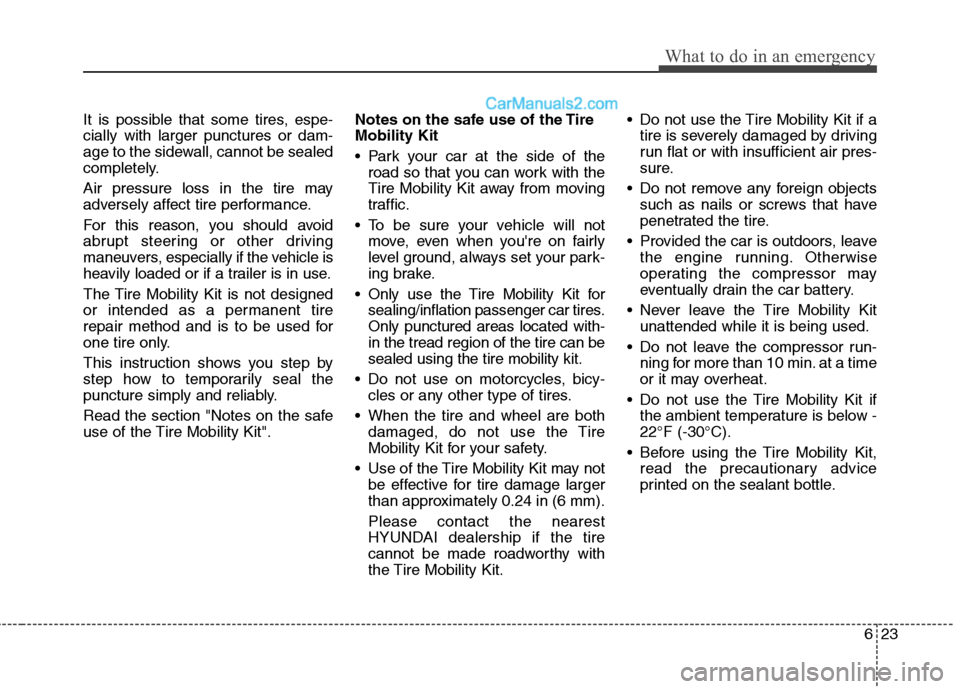
623
What to do in an emergency
It is possible that some tires, espe-
cially with larger punctures or dam-
age to the sidewall, cannot be sealed
completely.
Air pressure loss in the tire may
adversely affect tire performance.
For this reason, you should avoid
abrupt steering or other driving
maneuvers, especially if the vehicle is
heavily loaded or if a trailer is in use.
The Tire Mobility Kit is not designed
or intended as a permanent tire
repair method and is to be used for
one tire only.
This instruction shows you step by
step how to temporarily seal the
puncture simply and reliably.
Read the section "Notes on the safe
use of the Tire Mobility Kit".Notes on the safe use of the Tire
Mobility Kit
Park your car at the side of the
road so that you can work with the
Tire Mobility Kit away from moving
traffic.
To be sure your vehicle will not
move, even when you're on fairly
level ground, always set your park-
ing brake.
Only use the Tire Mobility Kit for
sealing/inflation passenger car tires.
Only punctured areas located with-
in the tread region of the tire can be
sealed using the tire mobility kit.
Do not use on motorcycles, bicy-
cles or any other type of tires.
When the tire and wheel are both
damaged, do not use the Tire
Mobility Kit for your safety.
Use of the Tire Mobility Kit may not
be effective for tire damage larger
than approximately 0.24 in (6 mm).
Please contact the nearest
HYUNDAI dealership if the tire
cannot be made roadworthy with
the Tire Mobility Kit. Do not use the Tire Mobility Kit if a
tire is severely damaged by driving
run flat or with insufficient air pres-
sure.
Do not remove any foreign objects
such as nails or screws that have
penetrated the tire.
Provided the car is outdoors, leave
the engine running. Otherwise
operating the compressor may
eventually drain the car battery.
Never leave the Tire Mobility Kit
unattended while it is being used.
Do not leave the compressor run-
ning for more than 10 min. at a time
or it may overheat.
Do not use the Tire Mobility Kit if
the ambient temperature is below -
22°F (-30°C).
Before using the Tire Mobility Kit,
read the precautionary advice
printed on the sealant bottle.
Page 420 of 425
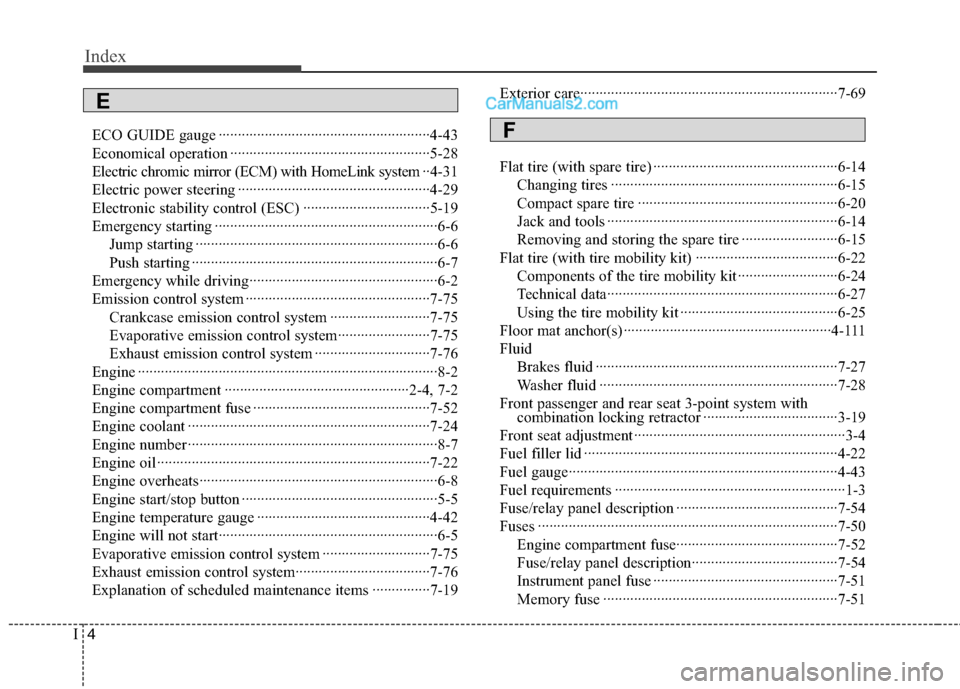
Index
4I
ECO GUIDE gauge ·······················································4-43
Economical operation ····················································5-28
Electric chromic mirror (ECM) with HomeLink system··4-31
Electric power steering ··················································4-29
Electronic stability control (ESC) ·································5-19
Emergency starting ··························································6-6
Jump starting ·······························································6-6
Push starting ································································6-7
Emergency while driving·················································6-2
Emission control system ················································7-75
Crankcase emission control system ··························7-75
Evaporative emission control system························7-75
Exhaust emission control system ······························7-76
Engine ··············································································8-2
Engine compartment ················································2-4, 7-2
Engine compartment fuse ··············································7-52
Engine coolant ·······························································7-24
Engine number ·································································8-7
Engine oil ·······································································7-22
Engine overheats······························································6-8
Engine start/stop button ···················································5-5
Engine temperature gauge ·············································4-42
Engine will not start·························································6-5
Evaporative emission control system ····························7-75
Exhaust emission control system···································7-76
Explanation of scheduled maintenance items ···············7-19Exterior care···································································7-69
Flat tire (with spare tire) ················································6-14
Changing tires ···························································6-15
Compact spare tire ····················································6-20
Jack and tools ····························································6-14
Removing and storing the spare tire ·························6-15
Flat tire (with tire mobility kit) ·····································6-22
Components of the tire mobility kit ··························6-24
Technical data····························································6-27
Using the tire mobility kit ·········································6-25
Floor mat anchor(s) ······················································4-111
Fluid
Brakes fluid ·······························································7-27
Washer fluid ······························································7-28
Front passenger and rear seat 3-point system with
combination locking retractor ···································3-19
Front seat adjustment ·······················································3-4
Fuel filler lid ··································································4-22
Fuel gauge······································································4-43
Fuel requirements ····························································1-3
Fuse/relay panel description ··········································7-54
Fuses ··············································································7-50
Engine compartment fuse··········································7-52
Fuse/relay panel description······································7-54
Instrument panel fuse ················································7-51
Memory fuse ·····························································7-51
E
F
Page 423 of 425

I7
Index
Occupant classification system······································3-42
Odometer ·······································································4-41
Oil (Engine) ···································································7-22
Outside rearview mirror·················································4-38
Overheats ·········································································6-8
Owner maintenance ·························································7-5
Panorama sunroof ··························································4-25
Parking brake ·································································5-16
Parking brake inspect·····················································7-28
Passenger's front air bag ················································3-48
Power brakes··································································5-14
Power outlet ·································································4-110
Power window lock button ············································4-20
Pre-tensioner seat belt····················································3-21
Push starting·····································································6-7
Rear seat·········································································3-11
Rear view camera ··························································4-70
Recommended cold tire inflation pressures ··················7-37
Recommended lubricants and capacities ·························8-5
Recommended SAE viscosity number························8-6Refrigerant label ······························································8-8
Replacement light bulb ··················································7-60
Reporting safety defects ················································8-10
Road warning ···································································6-2
Rocking the vehicle ·······················································5-30
Scheduled maintenance service ·······································7-7
Maintenance under severe usage conditions ·············7-18
Normal maintenance schedule ····································7-8
Seat belt warning ···························································3-16
Seat belts ········································································3-15
Driver's 3-point system with emergency locking
retractor ···································································3-17
Front passenger and rear seat 3-point system with
combination locking retractor ·································3-19
Height adjustment ·····················································3-18
Pre-tensioner seat belt ···············································3-21
Seat belt warning·······················································3-16
Seat belts height adjustment ··········································3-18
Seat warmer ····························································3-9, 3-12
Seatback pocket ·····························································3-10
Seats ·················································································3-2
Armrest ······································································3-13
Front seat adjustment ··················································3-4
Headrest ·····························································3-7, 3-11
Rear seat ····································································3-11
Seat warmer ·······················································3-9, 3-12
P
R
S
O